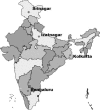Genetic characterization of Fasciola gigantica from different geographical regions of India by ribosomal DNA markers
- PMID: 25698855
- PMCID: PMC4328017
- DOI: 10.1007/s12639-013-0276-7
Genetic characterization of Fasciola gigantica from different geographical regions of India by ribosomal DNA markers
Abstract
Ribosomal DNA sequences of the second internal transcribed spacer (ITS-2) and 28S ribosomal DNA (618 bp) of Fasciola gigantica collected from cattle and buffaloes from four different geographical locations of India, were characterized for genotyping. ITS-2 sequence was analyzed in 28 worms that was typical of F. gigantica and differed at six positions, with one of these being a distinguishing deletion (T) at the 327th position in F. gigantica relative to F. hepatica. However, Fasciola specimens also showed intraspecies sequence polymorphism in the ITS-2, with two different ITS-2 sequences existing in the ribosomal DNA (rDNA) array within a single Fasciola worm. One of the sequences was identical to that of F. gigantica and the other showed extensive sequence polymorphism in the ITS-2. Using BspH1-restriction fragment length polymorphism, six variable ITS-2 sequences in F. gigantica were identified within these parasite specimens and were found distributed in these four geographical regions. 28S rDNA sequence of 24 flukes, collected from the above four geographical regions, showed a single nucleotide polymorphism at 284th nucleotide (G/A). Analyzing the sequence data of 28S rDNA of F. gigantica available from some African and Asian countries for this polymorphic 284th nucleotide position, it is proposed that there are two basic lineages of the F. gigantica for 28S rDNA existing in the fluke populations from five African and several Asian countries.
Keywords: 28S ribosomal DNA; Fasciola gigantica; Genetic characterization; ITS-2.
Figures



Similar articles
-
Sequence analysis of the first internal transcribed spacer of rDNA supports the existence of the intermediate Fasciola between F. hepatica and F. gigantica in mainland China.Parasitol Res. 2007 Aug;101(3):813-7. doi: 10.1007/s00436-007-0512-0. Epub 2007 Mar 15. Parasitol Res. 2007. PMID: 17356892
-
Molecular characterization of Fasciola spp. from the endemic area of northern Iran based on nuclear ribosomal DNA sequences.Exp Parasitol. 2011 Jul;128(3):196-204. doi: 10.1016/j.exppara.2011.03.011. Epub 2011 Apr 2. Exp Parasitol. 2011. PMID: 21440546
-
Molecular characterization of Fasciola gigantica from Mauritania based on mitochondrial and nuclear ribosomal DNA sequences.Exp Parasitol. 2011 Oct;129(2):127-36. doi: 10.1016/j.exppara.2011.07.002. Epub 2011 Jul 8. Exp Parasitol. 2011. PMID: 21763690
-
Characterisation of Fasciola species from Mainland China by ITS-2 ribosomal DNA sequence.Vet Parasitol. 2004 Feb 26;120(1-2):75-83. doi: 10.1016/j.vetpar.2003.12.006. Vet Parasitol. 2004. PMID: 15019145
-
Chapter 2. Fasciola, lymnaeids and human fascioliasis, with a global overview on disease transmission, epidemiology, evolutionary genetics, molecular epidemiology and control.Adv Parasitol. 2009;69:41-146. doi: 10.1016/S0065-308X(09)69002-3. Adv Parasitol. 2009. PMID: 19622408 Review.
Cited by
-
Morphological and molecular discrimination of fasciola species isolated from domestic ruminants of urmia city, iran.Iran J Parasitol. 2015 Jan-Mar;10(1):46-55. Iran J Parasitol. 2015. PMID: 25904945 Free PMC article.
-
Seasonal dynamics and molecular phylogenetic studies on cercariae in Central Zone of Kashmir valley.PLoS One. 2025 Jul 10;20(7):e0325160. doi: 10.1371/journal.pone.0325160. eCollection 2025. PLoS One. 2025. PMID: 40638602 Free PMC article.
-
Molecular Characterization of Fasciola hepatica in Sheep Based on DNA Sequences of Ribosomal ITS-1.Infect Drug Resist. 2023 Oct 12;16:6661-6671. doi: 10.2147/IDR.S421206. eCollection 2023. Infect Drug Resist. 2023. PMID: 37849790 Free PMC article.
-
Emerging Human Fascioliasis in India: Review of Case Reports, Climate Change Impact, and Geo-Historical Correlation Defining Areas and Seasons of High Infection Risk.Trop Med Infect Dis. 2025 May 2;10(5):123. doi: 10.3390/tropicalmed10050123. Trop Med Infect Dis. 2025. PMID: 40423353 Free PMC article.
-
Identification and Genetic Characterization of Fasciola hepatica Isolated from Cattle in Jeddah, Saudi Arabia Based on Sequence Analysis of Mitochondrial (COI) Gene.Infect Drug Resist. 2022 Aug 26;15:4877-4886. doi: 10.2147/IDR.S375671. eCollection 2022. Infect Drug Resist. 2022. PMID: 36051657 Free PMC article.
References
-
- Ali H, Ai L, Song HQ, Ali S, Lin RQ, Seyni B, Issa G, Zhu XQ. Genetic characterization of Fasciola samples from different host species and geographical localities revealed the existence of F. hepatica and F. gigantica in Niger. Parasitol Res. 2008;102:1021–1024. doi: 10.1007/s00436-007-0870-7. - DOI - PubMed
-
- Gunasekar KR, Tewari AK, Sreekumar C, Gupta SC, Rao JR. Elucidation of genetic variability among different isolates of Fasciola gigantica (giant liver fluke) using random-amplified polymorphic DNA-polymerase chain reaction. Parasitol Res. 2008;103:1075–1081. doi: 10.1007/s00436-008-1095-0. - DOI - PubMed
LinkOut - more resources
Full Text Sources
Other Literature Sources
